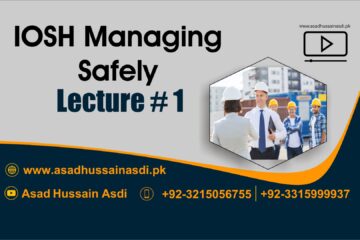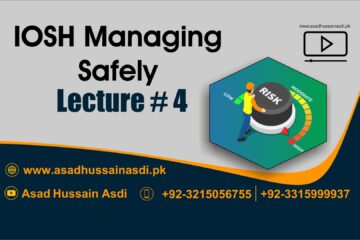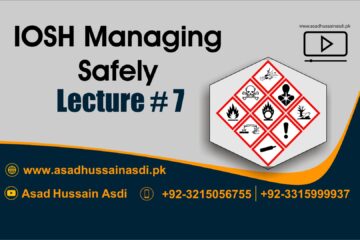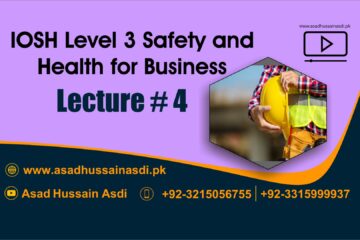ProQual Level 2 NVQ Diploma in Controlling Lifting Operations – Slinger/Signaller (Construction) Course in Islamabad || Registration Open
Registration Open= +92-3315999937, +92- 3215056755 (WhatsApp Only)
Introduction
The ProQual Level 2 NVQ Diploma in Controlling Lifting Operations – Slinger/Signaller
qualification provides a nationally recognised qualification for individuals who work or want
to work in the construction industry and specialise in the lifting suspended loads.
The awarding body for the qualification is ProQual Awarding Body and the regulatory body
is the Office of Qualifications and Examinations Regulation (Ofqual). The specification for
this qualification has been approved by the Council for the Curriculum Examinations and
Assessment (CCEA) for use by centres in Northern Ireland.
This qualification has been accredited onto the Regulated Qualifications Framework and it
provides a progression route to discipline related qualifications.
Qualification Profile
Level 2 NVQ Diploma in Controlling Lifting Operations –
Slinger/Signaller Lifts (Construction)
Qualification title ProQual Level 2 NVQ Diploma in Controlling Lifting
Operations – Slinger/Signaller
Ofqual qualification number 600/9043/1
Level Level 2
Guided learning hours 144
Total qualification time 430
Assessment
Pass or fail
Internally assessed and verified by centre staff
External quality assurance by ProQual verifiers
Qualification start date 1/5/13
Qualification end date
Entry Requirements
There are no formal entry requirements for this qualification.
Centres should carry out an initial assessment of candidate skills and knowledge to identify
any gaps and help plan the assessment.
Qualification Structure
ProQual, April 2019
Level 2 NVQ Diploma in Controlling Lifting Operations – Slinger/Signaller
4
To achieve the qualification candidates must complete all of the Mandatory units. Unit
Endorsement information is included in the qualification structure information below (CITB
reference numbers are given for information only.)
Mandatory Units
Unit
Reference
Number
Unit Title Unit
Level GLH
CITB
Ref.
No
D/615/4938
Attaching and preparing suspended loads for movement
using lifting accessories in the workplace
Unit Endorsement:
The following endorsement required (i.e. own area of work):
Slinger/signaller – all occupations
2 47 402B
H/615/4939
Guiding, positioning and placing suspended loads in the
workplace
Unit Endorsement:
The following endorsement required (i.e. own area of work):
Slinger/signaller – all occupations
2 80 402C
T/508/6538 Conforming to productive working practices in the
workplace 2 7 641
M/508/6537 Conforming to general health, safety and welfare in the
workplace 1 10 642
Centre Requirements
Centres must be approved to offer this qualification. If your centre is not approved please
complete and submit form ProQual Additional Qualification Approval Application.
Staff
Staff delivering this qualification must be appropriately qualified and/or occupationally
competent.
Assessors/Internal Quality Assurance
For each competence-based unit centres must be able to provide at least one assessor and
one internal quality assurance verifier who are suitably qualified for the specific
occupational area. Assessors and internal quality assurance verifiers for competence-based
units or qualifications will normally need to hold appropriate assessor or verifier
qualifications, such as:
- Award in Assessing Competence in the Work Environment
- Award in Assessing Vocationally Related Achievement
- Certificate in Assessing Vocational Achievement
- Award in the Internal Quality Assurance of Assessment Processes and Practices
- Certificate in Leading the Internal Quality Assurance of Assessment Processes and
Practices
Support for Candidates
ProQual, April 2019
Level 2 NVQ Diploma in Controlling Lifting Operations – Slinger/Signaller
5
Materials produced by centres to support candidates should:
- enable them to track their achievements as they progress through the learning
outcomes and assessment criteria;
- provide information on where ProQual’s policies and procedures can be viewed;
- provide a means of enabling Internal and External Quality Assurance staff to
authenticate evidence
Links to National Standards / NOS mapping
National Occupational Standards (NOS) are owned by a Sector Skills Council or Standard
Setting Body and they describe the skills, knowledge and understanding needed to
undertake a particular task or job at different levels of competence.
The structure and units of this qualification are based on NOS for the construction sector.
Assessment
This qualification is competence-based, candidates must demonstrate the level of
competence described in the units. Assessment is the process of measuring a candidate’s
skill, knowledge and understanding against the standards set in the qualification.
The qualification must be assessed in line with the Construction Sector Qualifications
Strategy and must be internally assessed by an appropriately experienced and qualified
assessor.
Each candidate is required to produce a portfolio of evidence which demonstrates their
achievement of all of the learning outcomes and assessment criteria for each unit.
Evidence can include: – observation report by assessor
– assignments/projects/reports
– professional discussion
– witness testimony
– candidate product
– worksheets
– record of oral and written questioning
– Recognition of Prior Learning
ProQual, April 2019
Level 2 NVQ Diploma in Controlling Lifting Operations – Slinger/Signaller
6
Learning outcomes set out what a candidate is expected to know, understand or be able to
do.
Assessment criteria specify the standard a candidate must meet to show the learning
outcome has been achieved.
Learning outcomes and assessment criteria can be found from page 8 onwards.
Internal Quality Assurance
An internal quality assurance verifier confirms that assessment decisions made in centres
are made by competent and qualified assessors, that they are the result of sound and fair
assessment practice and that they are recorded accurately and appropriately.
Adjustments to Assessment
Adjustments to standard assessment arrangements are made on the individual needs of
candidates. ProQual’s Reasonable Adjustments Policy and Special Consideration Policy sets
out the steps to follow when implementing reasonable adjustments and special
considerations and the service that ProQual provides for some of these arrangements.
Centres should contact ProQual for further information or queries about the contents of the
policy.
Results Enquiries and Appeals
All enquiries relating to assessment or other decisions should be dealt with by centres, with
reference to ProQual’s Enquiries and Appeals Procedures.
ProQual, April 2019
Level 2 NVQ Diploma in Controlling Lifting Operations – Slinger/Signaller
7
Certification
Candidates who achieve the required units for the qualification will be awarded:
- A certificate listing all units achieved, and
- A certificate giving the full qualification title –
ProQual Level 2 NVQ Diploma in Controlling Lifting Operations – Slinger/Signaller
Claiming certificates
Centres may claim certificates for candidates who have been registered with ProQual and
who have successfully completed the qualification. All certificates will be issued to the
centre.
Unit certificates
If a candidate does not achieve all of the units required for a qualification, the centre may
claim a unit certificate for the candidate which will list all of the units achieved.
Replacement certificates
If a replacement certificate is required a request must be made to ProQual in writing.
Replacement certificates are labelled as such and are only provided when the claim has
been authenticated. Refer to the Fee Schedule for details of charges for replacement
certificates.
Learning outcomes and assessment criteria
ProQual, April 2019
Level 2 NVQ Diploma in Controlling Lifting Operations – Slinger/Signaller
8
Title: Attaching and preparing suspended loads for movement using lifting
accessories in the workplace
Unit Number: D/615/4938
Learning outcomes
The learner will be able to:
Assessment criteria
The learner can:
1 Interpret the given
information relating to the
work and resources when
attaching and preparing
suspended loads for
movement.
1.1 Interpret and extract relevant information from
drawings, specifications, schedules, method statements
(lift plans), risk assessments, certificates and
manufacturers’ information.
1.2 Comply with information and/or instructions derived
from risk assessments and method statement.
1.3 Describe the organisational procedures developed to
report and rectify inappropriate information and
unsuitable resources and how they are implemented.
1.4 Describe different types of information, their source and how
they are interpreted in relation to:
– drawings, specifications, schedules, risk assessments,
method statements, lift plans, work instructions,
certificates, manufacturers’ information approved
procedures and Codes of Practice.
2 Organise with others in
which the sequence and
operation for attaching and
preparing suspended loads
for movement is to be
carried out.
2.1 Organise the checking and preparation work according
to given information or instructions.
2.2 Describe how to communicate ideas between team
members.
2.3 Organise and communicate the sequence and operation
with team members and/or other associated
occupations when attaching and preparing suspended
loads for movement.
2.4 Describe how to organise resources prior to and when
attaching and preparing suspended loads for movement.
3 Know how to comply with
relevant legislation and
official guidance when
attaching and preparing
suspended loads for
movement.
3.1 Describe their responsibilities regarding potential accidents,
health hazards and the environment whilst working:
– in the workplace, below ground level, in confined spaces,
at height, with tools and equipment, with materials and
substances, with movement/storage of materials and by
manual handling and mechanical lifting.
3.2 Describe the organisational security procedures for
tools, equipment and personal belongings in relation to
site, workplace, company and operative.
3.3 Explain what the accident reporting procedures are and
who is responsible for making reports.
Learning outcomes and assessment criteria
ProQual, April 2019
Level 2 NVQ Diploma in Controlling Lifting Operations – Slinger/Signaller
9
Title: Attaching and preparing suspended loads for movement using lifting
accessories in the workplace
Learning outcomes
The learner will be able to:
Assessment criteria
The learner can:
4 Maintain safe and healthy
working practices when
attaching and preparing
suspended loads for
movement.
4.1 Use health and safety control equipment safely and
comply with the methods of work to carry out the
activity in accordance with legislation and organisational
requirements when attaching and preparing suspended
loads for movement.
4.2 Demonstrate compliance with given information and
relevant legislation when attaching and preparing
suspended loads for movement in relation to at least
three of the following:
– safe use and storage of tools and equipment
– safe use, storage and handling of lifting accessories
– safe use of access equipment
– specific risks to health.
4.3 Explain why and when health and safety control equipment,
identified by the principles of prevention, should be used,
relating to attaching and preparing suspended loads for
movement, and the types, purpose and limitations of each
type, the work situation and general work environment, in
relation to:
– collective protective measures
– personal protective equipment (PPE)
– respiratory protective equipment (RPE)
– local exhaust ventilation (LEV).
4.4 Describe how the relevant health and safety control
equipment should be used in accordance with the given
working instructions.
4.5 Describe how emergencies should be responded to in
accordance with organisational authorisation and
personal skills when involved with fires, spillages,
injuries and other task-related activities.
5 Select the required quantity
and quality of resources for
the methods of work to
attach and prepare
suspended loads for
movement.
5.1 Select resources associated with own work in relation to
lifting accessories/aids, hand tools and ancillary
equipment.
5.2 Describe the characteristics, quality, uses, sustainability,
limitations and defects associated with the resources, and
how they should be used correctly, in relation to:
– lifting accessories, steel wire rope, chain, fabric, web
hooks, shackles, clamps, spreader and lifting beams, and
other specialist lifting equipment
– tools and ancillary equipment.
Learning outcomes and assessment criteria
ProQual, April 2019
Level 2 NVQ Diploma in Controlling Lifting Operations – Slinger/Signaller
10
Title: Attaching and preparing suspended loads for movement using lifting
accessories in the workplace
Learning outcomes
The learner will be able to:
Assessment criteria
The learner can:
5 Continued 5.3 Describe how the resources should be used correctly
and how problems associated with the resources are
reported.
5.4 Explain why the organisational procedures have been
developed and how they are used for the selection of
required resources.
5.5 Describe any potential hazards associated with the
resources and method of work.
5.6 Identify or estimate weights, quantity, length and area,
and identify centres of gravity relevant to attaching and
preparing suspended loads.
5.7 Describe how to identify weight, quantity, length and
area associated with the method/procedure to attach
and prepare suspended loads for movement.
6 Minimise the risk of damage
to the work and
surrounding area when
attaching and preparing
suspended loads for
movement.
6.1 Protect the work and its surrounding area from damage
in accordance with safe working practices and
organisational procedures.
6.2 Prevent damage and maintain a clean work space.
6.3 Dispose of waste in accordance with current legislation.
6.4 Describe how to protect work from damage and the
purpose of protection in relation to general workplace
activities, other occupations and adverse weather
conditions.
6.5 Explain why the disposal of waste should be carried out safely
in accordance with environmental responsibilities,
organisational procedures, manufacturers’ information,
statutory regulations and official guidance.
7 Complete the work within
the allocated time when
attaching and preparing
suspended loads for
movement.
7.1 Demonstrate completion of the work within the allocated
time.
7.2 Describe the purpose of the work programme and explain
why deadlines should be kept in relation to:
– types of progress charts, timetables and estimated times
– organisational procedures for reporting circumstances
which will affect the work programme.
Learning outcomes and assessment criteria
ProQual, April 2019
Level 2 NVQ Diploma in Controlling Lifting Operations – Slinger/Signaller
11
Title: Attaching and preparing suspended loads for movement using lifting
accessories in the workplace
Learning outcomes
The learner will be able to:
Assessment criteria
The learner can:
8 Comply with the given
contract information to
attach and prepare
suspended loads for
movement using lifting
accessories to the required
specification.
8.1 Demonstrate the following work skills when attaching
and preparing suspended loads for movement:
– measuring, selecting, gauging, estimating,
calculating, fitting, fixing, testing, balancing,
interpreting, checking, judging, explaining,
preparing, informing, adjusting, configuring,
positioning, moving, securing, removing and
signalling.
8.2 Use and maintain lifting accessories, lifting aids and
equipment.
8.3 Carry out pre-use checks on a range of lifting accessories
in preparation for attaching to suspended loads.
8.4 Select appropriate lifting accessories in accordance with
given working instructions.
8.5 Prepare to and attach suspended loads to lifting
equipment, using appropriate lifting accessories and
load securing methods, to given working instructions
for the following:
– balanced
– unbalanced
– loose
– bundled
– container-type
– drum-type.
8.6 Remove lifting accessories from a range of loads on
completion of movement and leave loads in a safe
situation.
Learning outcomes and assessment criteria
ProQual, April 2019
Level 2 NVQ Diploma in Controlling Lifting Operations – Slinger/Signaller
12
Title: Attaching and preparing suspended loads for movement using lifting
accessories in the workplace
Learning outcomes
The learner will be able to:
Assessment criteria
The learner can:
8 Continued 8.7 Describe how to apply safe work practices, follow procedures,
report problems and establish the authority needed to rectify
them, to:
– identify the differences between: slinging and signalling,
directing and guiding movement of vehicles, plant and
machinery, and directing and guiding operations of plant
and machinery not being used for lifting operations
– confirm the authority, duties and responsibilities
allocated
– identify characteristics of lifting equipment and lifting
accessories and determine the method for attaching and
securing
– identify and interpret valid certification for maintenance,
inspection and thorough examination
– lift and transfer people
– sling balanced, unbalanced, loose, live, bundled,
container drum loads
– communicate using hand signals, hand signalling
equipment (lights, wands, fluorescent gloves, flags) and
electronic communication equipment (loud hailers,
radios)
– confirm methods of communication
– recognise blind-spots, potential crush zones and other
limitations to operator visibility
– consider the load characteristics including centre of
gravity and lifting points to determine the method of
slinging
– determine and check the route of the load before and
during the lift including distances, clearances and landing
position
– select, handle, check and use (assemble, set up and
adjust) lifting accessories and aids
– identify rejection criteria for removing defective lifting
accessories from service
– recognise and determine when specific skills and
knowledge are required and report accordingly
– attach lifting accessories and sling loads securely
– ensure balance and stability of loads
– attach and use load guidance equipment (hand/tag lines)
– land and position loads safely and securely
– remove and store lifting accessories
– use hand tools and ancillary equipment.
– work at height.
Learning outcomes and assessment criteria
ProQual, April 2019
Level 2 NVQ Diploma in Controlling Lifting Operations – Slinger/Signaller
13
8 Continued 8.8 Describe the needs of other occupations and how to
communicate within a team when attaching and
preparing suspended loads for movement.
8.9 Describe how to maintain the lifting accessories, aids
and equipment used to attach suspended loads for
movement.
Title: Attaching and preparing suspended loads for movement using lifting
accessories in the workplace
Additional information about this unit
Assessment Guidance This unit must be assessed in a work environment and in
accordance with the ConstructionSkills‘ Consolidated
Assessment Strategy for Construction and the Built
Environment.
Assessors for this unit must have verifiable, current industry
experience and a sufficient depth of occupational expertise
and knowledge, and must use a combination of assessment
methods as defined in the Consolidated Assessment Strategy.
Workplace evidence of skills cannot be simulated.
This unit must be assessed against the endorsements detailed
within the relevant NVQ Structure.
ProQual Level 2 NVQ Diploma in Controlling Lifting Operations
– Slinger/Signaller
The following endorsement required (i.e. own area of work):
Slinger signaller – all occupations
Sector subject area 5.2 Building and Construction
Availability for use Shared unit
Unit guided learning hours 80
Learning outcomes and assessment criteria
ProQual, April 2019
Level 2 NVQ Diploma in Controlling Lifting Operations – Slinger/Signaller
14
Title: Guiding, positioning and placing suspended loads in the workplace
Unit Number: H/615/4939
Learning outcomes
The learner will be able to:
Assessment criteria
The learner can:
1 Interpret the given
information relating to the
work and resources when
guiding, positioning and
placing suspended loads.
1.1 Interpret and extract relevant information from
drawings, specifications, schedules, method statements
(lift plans), risk assessments, and manufacturers’
information.
1.2 Comply with information and/or instructions derived
from risk assessments and method statement.
1.3 Describe the organisational procedures developed to
report and rectify inappropriate information and
unsuitable resources and how they are implemented.
1.4 Describe different types of information, their source and how
they are interpreted in relation to:
– drawings, specifications, schedules, risk assessments,
method statements, lift plans, work instructions,
manufacturers’ information approved procedures and
Codes of Practice.
2 Organise the sequence and
operation for guiding,
positioning and placing
suspended loads.
2.1 Organise the guiding, positioning and placing of
suspended loads according to given information or
instructions.
2.2 Describe how to communicate ideas between team
members.
2.3 Organise and communicate the sequence and operation
with team members and/or other associated
occupations when guiding and placing suspended loads.
2.4 Describe how to organise appropriate resources prior to
and when directing and guiding suspended loads.
3 Know how to comply with
relevant legislation and
official guidance when
guiding, positioning and
placing suspended loads.
3.1 Describe their responsibilities regarding potential accidents,
health hazards and the environment whilst working:
– in the workplace, below ground level, in confined spaces,
at height, with tools and equipment, with materials and
substances, with movement/storage of materials and by
manual handling and mechanical lifting.
3.2 Describe the organisational security procedures for
tools, equipment and personal belongings in relation to
site, workplace, company and operative.
3.3 Explain what the accident reporting procedures are and
who is responsible for making reports.
Learning outcomes and assessment criteria
ProQual, April 2019
Level 2 NVQ Diploma in Controlling Lifting Operations – Slinger/Signaller
15
Title: Guiding, positioning and placing suspended loads in the workplace
Learning outcomes
The learner will be able to:
Assessment criteria
The learner can:
4 Maintain safe and healthy
working practices when
guiding, positioning and
placing suspended loads.
4.1 Use health and safety control equipment safely and
comply with the methods of work to carry out the
activity in accordance with legislation and organisational
requirements when guiding, positioning and placing
suspended loads.
4.2 Demonstrate compliance with given information and relevant
legislation when guiding, positioning and placing suspended
loads in relation to at least three of the following:
– safe use and storage of tools and equipment
– safe use, storage and handling of lifting accessories
– safe use of access equipment
– specific risks to health.
4.3 Explain why and when health and safety control equipment,
identified by the principles of prevention, should be used,
relating to guiding, positioning and placing suspended loads,
and the types, purpose and limitations of each type, the work
situation and general work environment, in relation to:
– collective protective measures
– personal protective equipment (PPE)
– respiratory protective equipment (RPE)
– local exhaust ventilation (LEV).
4.4 Describe how the relevant health and safety control
equipment should be used in accordance with the given
working instructions.
4.5 Describe how emergencies should be responded to in
accordance with organisational authorisation and
personal skills when involved with fires, spillages,
injuries and other task-related activities.
5 Select the required quantity
and quality of resources for
the methods of work to
guide, position and place
suspended loads.
5.1 Select resources associated with own work in relation to
lifting accessories/aids, hand tools and ancillary
equipment.
5.2 Describe the characteristics, quality, uses, sustainability,
limitations and defects, and how they should be used
correctly, associated with the resources in relation to:
– signalling and communication equipment
– hand tools and ancillary equipment.
5.3 Describe how the resources should be used correctly
and how problems associated with the resources are
reported.
Learning outcomes and assessment criteria
ProQual, April 2019
Level 2 NVQ Diploma in Controlling Lifting Operations – Slinger/Signaller
16
Title: Guiding, positioning and placing suspended loads in the workplace
Learning outcomes
The learner will be able to:
Assessment criteria
The learner can:
5 Continued 5.4 Explain why the organisational procedures have been developed and
how they are used for the selection of required resources.
5.5 Describe any potential hazards associated with the resources and
methods of work.
5.6 Describe how to identify weight, quantity, length and area, associated
with the method/procedure to guide, position and place suspended
loads.
6 Minimise the risk of
damage to the work
and surrounding area
when guiding,
positioning and placing
suspended loads.
6.1 Protect the work and its surrounding area from damage in accordance
with safe working practices and organisational procedures.
6.2 Prevent damage and maintain a clean work space.
6.3 Dispose of waste in accordance with current legislation.
6.4 Describe how to protect work from damage and the purpose of
protection in relation to general workplace activities, other
occupations and adverse weather conditions.
6.5 Explain why the disposal of waste should be carried out safely in
accordance with environmental responsibilities, organisational
procedures, manufacturers’ information, statutory regulations and
official guidance.
7 Complete the work
within the allocated
time when guiding,
positioning and placing
suspended loads.
7.1 Demonstrate completion of the work within the allocated time.
7.2 Describe the purpose of the work programme and explain why
deadlines should be kept in relation to:
– types of progress charts, timetables and estimated times
– organisational procedures for reporting circumstances which will
affect the work programme.
8 Comply with the given
contract information to
guide, position and
place suspended loads
to the required
specification.
8.1 Demonstrate the following work skills when guiding and placing
suspended loads:
– indicating, informing, instructing, positioning, moving, signalling
and relaying.
Learning outcomes and assessment criteria
ProQual, April 2019
Level 2 NVQ Diploma in Controlling Lifting Operations – Slinger/Signaller
17
Title: Guiding, positioning and placing suspended loads in the workplace
Learning outcomes
The learner will be able to:
Assessment criteria
The learner can:
8 Continued 8.2 Use and maintain signalling equipment.
8.3 Guide and move suspended loads to specified destinations, using
hand signals, hand-held signalling equipment and electronic
communication equipment, to given working instructions for the
following:
– balanced
– unbalanced
– loose
– bundled
– container
– drum
– loads where the machine operator cannot observe the full movement
path.
8.4 Position and place a range of loads to given working instructions.
8.5 Remove lifting accessories from a range of loads on completion of
movement and leave loads in a safe situation.
8.6 Describe how to apply safe work practices, follow procedures, report
problems and establish the authority needed to rectify them, to:
– identify the differences between: slinging and signalling, directing and
guiding movement of vehicles, plant and machinery, and directing and
guiding operations of plant and machinery not being used for lifting
operations
– confirm the authority, duties and responsibilities allocated
– identify characteristics of lifting equipment and lifting accessories
– lift and transfer people
– communicate using hand signals, hand signalling equipment (lights,
wands, fluorescent gloves, flags) and electronic communication
equipment (loud hailers, radios)
– confirm methods of communication
– recognise blind-spots, potential crush zones and other limitations to
driver visibility
– consider the load characteristics including centre of gravity and lifting
points to determine the method of removing lifting accessories
– determine and check the route of the load before and during the lift
including distances, clearances and landing position
– handle and use (set up and adjust) lifting aids
– recognise and determine when specific skills and knowledge are required
and report accordingly
– ensure balance and stability of loads
– attach and use load guidance equipment (hand/tag lines)
– guide, position and place suspended loads by recognised methods of
signalling and communication and agreed operational procedures
– land and position loads safely and securely
– remove and store lifting accessories
– use hand tools and ancillary equipment.
– work at height.
8.7 Describe the needs of other occupations and how to communicate
within a team when guiding and placing suspended loads.
8.8 Describe how to maintain signalling and communication equipment
used when guiding and placing suspended loads.
Learning outcomes and assessment criteria
ProQual, April 2019
Level 2 NVQ Diploma in Controlling Lifting Operations – Slinger/Signaller
18
Title: Guiding, positioning and placing suspended loads in the workplace
Additional information about this unit
Assessment Guidance This unit must be assessed in a work environment and in accordance
with the ConstructionSkills‘ Consolidated Assessment Strategy for
Construction and the Built Environment.
Assessors for this unit must have verifiable, current industry
experience and a sufficient depth of occupational expertise and
knowledge, and must use a combination of assessment methods as
defined in the Consolidated Assessment Strategy.
Workplace evidence of skills cannot be simulated.
This unit must be assessed against the endorsements detailed within
the relevant NVQ Structure.
ProQual Level 2 NVQ Diploma in Controlling Lifting Operations –
Slinger/Signaller:
The following endorsement required (i.e. own area of work): Slinger
signaller – all occupations
Sector subject area 5.2 Building and Construction
Availability for use Shared unit
Unit guided learning
hours
47
Learning outcomes and assessment criteria
ProQual, April 2019
Level 2 NVQ Diploma in Controlling Lifting Operations – Slinger/Signaller
19
Title: Conforming to general health, safety and welfare in the workplace.
Unit Number: M/508/6537
Learning outcomes
The learner will be able to:
Assessment criteria
The learner can:
1 Comply with all workplace
health, safety and welfare
legislation requirements.
1.1 Comply with information from workplace inductions and any
health, safety and welfare briefings attended relevant to the
occupational area.
1.2 Use health and safety control equipment safely to carry out
the activity in accordance with legislation and organisational
requirements.
1.3 Comply with statutory requirements, safety notices and
warning notices displayed within the workplace and/or on
equipment.
1.4 State why and when health and safety control equipment,
identified by the principles of protection, should be used
relating to types, purpose and limitations of each type, the
work situation, occupational use and the general work
environment, in relation to:
– collective protective measures
– personal protective equipment (PPE)
– respiratory protective equipment (RPE)
– local exhaust ventilation (LEV).
1.5 State how the health and safety control equipment relevant
to the work should be used in accordance with the given
instructions.
1.6 State which types of health, safety and welfare legislation,
notices and warning signs are relevant to the occupational
area and associated equipment.
1.7 State why health, safety and welfare legislation, notices and
warning signs are relevant to the occupational area.
1.8 State how to comply with control measures that have been
identified by risk assessments and safe systems of work.
2 Recognise hazards
associated with the
workplace that have not
been previously controlled
and report them in
accordance with
organisational procedures.
2.1 Report any hazards created by changing circumstances
within the workplace in accordance with organisational
procedures.
2.2 List typical hazards associated with the work environment
and occupational area in relation to resources, substances,
asbestos, equipment, obstructions, storage, services and
work activities.
2.3 List the current Health and Safety Executive top ten safety
risks.
Learning outcomes and assessment criteria
ProQual, April 2019
Level 2 NVQ Diploma in Controlling Lifting Operations – Slinger/Signaller
20
Title: Conforming to general health, safety and welfare in the workplace.
Learning outcomes
The learner will be able to:
Assessment criteria
The learner can:
2 continued 2.4 List the current Health and Safety Executive top five
health risks.
2.5 State how changing circumstances within the workplace
could cause hazards.
2.6 State the methods used for reporting changed
circumstances, hazards and incidents in the workplace.
3 Comply with organisational
policies and procedures to
contribute to health, safety
and welfare.
3.1 Interpret and comply with given instructions to maintain
safe systems of work and quality working practices.
3.2 Contribute to discussions by offering/providing
feedback relating to health, safety and welfare.
3.3 Contribute to the maintenance of workplace welfare
facilities in accordance with workplace welfare
procedures.
3.4 Safely store health and safety control equipment in
accordance with given instructions.
3.5 Dispose of waste and/or consumable items in
accordance with legislation.
3.6 State the organisational policies and procedures for
health, safety and welfare, in relation to:
– dealing with accidents and emergencies associated
with the work and environment
– methods of receiving or sourcing information
– reporting
– stopping work
– evacuation
– fire risks and safe exit procedures
– consultation and feedback.
3.7 State the appropriate types of fire extinguishers
relevant to the work.
3.8 State how and when the different types of fire
extinguishers are used in accordance with legislation
and official guidance.
Learning outcomes and assessment criteria
ProQual, April 2019
Level 2 NVQ Diploma in Controlling Lifting Operations – Slinger/Signaller
21
Title: Conforming to general health, safety and welfare in the workplace.
Learning outcomes
The learner will be able to:
Assessment criteria
The learner can:
4 Work responsibly to
contribute to workplace
health, safety and welfare
whilst carrying out work in
the relevant occupational
area.
4.1 Demonstrate behaviour which shows personal
responsibility for general workplace health, safety and
welfare.
4.2 State how personal behaviour demonstrates
responsibility for general workplace health, safety and
welfare, in relation to:
– recognising when to stop work in the face of serious
and imminent danger to self and/or others
– contributing to discussions and providing feedback
– reporting changed circumstances and incidents in
the workplace
– complying with the environmental requirements of
the workplace.
4.3 Give examples of how the behaviour and actions of
individuals could affect others within the workplace.
5 Comply with and support all
organisational security
arrangements and approved
procedures.
5.1 Provide appropriate support for security arrangements
in accordance with approved procedures:
– during the working day
– on completion of the day’s work
– for unauthorised personnel (other operatives and
the general public)
– for theft.
5.2 State how security arrangements are implemented in
relation to the workplace, the general public, site
personnel and resources.
Learning outcomes and assessment criteria
ProQual, April 2019
Level 2 NVQ Diploma in Controlling Lifting Operations – Slinger/Signaller
22
Title: Conforming to general health, safety and welfare in the workplace.
Additional information about this unit
Assessment Guidance This unit must be assessed in a work environment, in
accordance with the ConstructionSkills‘ Consolidated
Assessment Strategy for Construction and the Built
Environment.
Assessors for this unit must have verifiable, current industry
experience and a sufficient depth of relevant occupational
expertise and knowledge, and must use a combination of
assessment methods as defined in the Consolidated
Assessment Strategy.
Workplace evidence of skills cannot be simulated.
Sector Subject Area 05.2 Building and Construction
Availability for use Shared unit
Credit value 2
Unit guided learning hours 7
Learning outcomes and assessment criteria
ProQual, April 2019
Level 2 NVQ Diploma in Controlling Lifting Operations – Slinger/Signaller
23
Title: Conforming to productive working practices in the workplace
Unit Number: T/508/6538
Learning outcomes
The learner will be able to:
Assessment criteria
The learner can:
1 Communicate with others to
establish productive work
practices.
1.1 Communicate in an appropriate manner with line
management, colleagues and/or customers to ensure that
work is carried out productively.
1.2 Describe the different methods of communicating with line
management, colleagues and customers.
1.3 Describe how to use different methods of
communication to ensure that the work carried out is
productive.
2 Follow organisational
procedures to plan the
sequence of work.
2.1 Interpret relevant information from organisational
procedures in order to plan the sequence of work.
2.2 Plan the sequence of work, using appropriate
resources, in accordance with organisational
procedures to ensure work is completed productively.
2.3 Describe how organisational procedures are applied to
ensure work is planned and carried out productively, in
relation to:
– using resources for own and other’s work requirements
– allocating appropriate work to employees
– organising the work sequence
– reducing carbon emissions.
2.4 Describe how to contribute to zero/low carbon work
outcomes within the built environment.
3 Maintain relevant records in
accordance with the
organisational procedures.
3.1 Complete relevant documentation according to the
occupation as required by the organisation.
3.2 Describe how to complete and maintain documentation in
accordance with organisational procedures, in relation to:
– job cards
– worksheets
– material/resource lists
– time sheets.
3.3 Explain the reasons for ensuring documentation is
completed clearly and within given timescales.
4 Maintain good working
relationships when
conforming to productive
working practices.
4.1 Carry out work productively, to the agreed specification, in
conjunction with line management, colleagues, customers
and/or other relevant people involved in the work to
maintain good working relationships.
Learning outcomes and assessment criteria
ProQual, April 2019
Level 2 NVQ Diploma in Controlling Lifting Operations – Slinger/Signaller
24
Title: Conforming to productive working practices in the workplace
Learning outcomes
The learner will be able to:
Assessment criteria
The learner can:
4.2 Apply the principles of equality and diversity and respect
the needs of individuals when communicating and
working with others.
4.3 Describe how to maintain good working relationships, in
relation to:
– individuals
– customer and operative
– operative and line management
– own and other occupations.
4.4 Describe why it is important to work effectively with line
management, colleagues and customers.
4.5 Describe how working relationships could have an effect
on productive working.
4.6 Describe how to apply principles of equality and diversity
when communicating and working with others.
Learning outcomes and assessment criteria
ProQual, April 2019
Level 2 NVQ Diploma in Controlling Lifting Operations – Slinger/Signaller
25
Title: Conforming to Productive Working Practices in the Workplace
Additional information about this unit
Assessment Guidance This unit must be assessed in a work environment, in
accordance with the ConstructionSkills‘ Consolidated
Assessment Strategy for Construction and the Built
Environment.
Assessors for this unit must have verifiable, current industry
experience and a sufficient depth of relevant occupational
expertise and knowledge, and must use a combination of
assessment methods as defined in the Consolidated






















